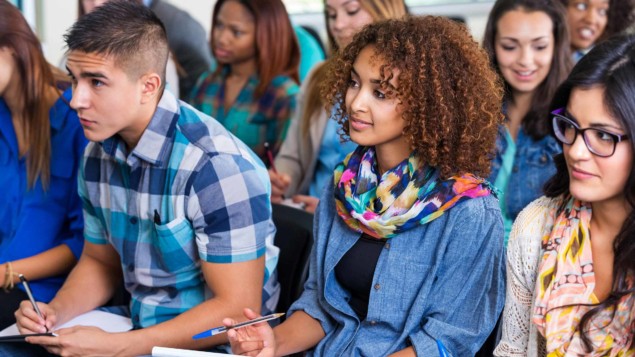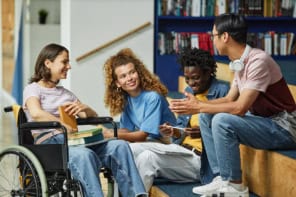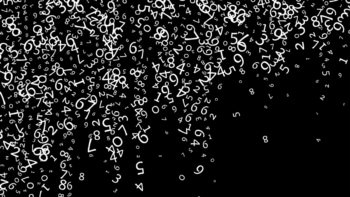Janice Hudgings and Chaelee Dalton describe how integrating pro-equity material into a standard physics curriculum can improve the learning experience of students from under-represented groups

Although there have been repeated calls over the years to increase the number of women and minority students in science, technology, engineering and mathematics (STEM) subjects, the demographics show that these fields still have a long way to go.
According to the American Physical Society, people who identify as Black, Hispanic or Native American are significantly under-represented in the numbers earning physics degrees in the US (APS survey). The American Institute of Physics found that the percentage of physics bachelor’s degrees earned by women in the US has decreased since 2000 to around 20% (AIP Statistical Research Center; www.aip.org/statistics). The reasons why these numbers remain so low are complex, but research suggests that the underlying culture of physics is unwelcoming for women, people of colour, LGBTQ+ physicists and other minority groups.
Many physics departments in the US have worked to shift towards “student-centred”, active learning in the classroom, which has widely been shown to improve students’ learning. However, while these changes are necessary, they are not sufficient. We must broaden our understanding of “student-centred” to include a focus on the different experiences and backgrounds of our students, particularly those outside of the dominant culture. Otherwise, even in classes where it appears that student retention and learning is positive overall, minority students and their voices will continue to be pushed to the margins.
The physics department at Pomona College prides itself on student-centred teaching and on building a welcoming community for physics students, but the demographics still match those seen across the rest of the US. We carried out a department-wide survey and also held classroom discussions to try to understand why. We found that most students seemed pleased with their experiences and spoke positively about the department community-building activities.
However, when we looked at the responses of women and students of colour, these minority voices – otherwise buried in those of the majority – painted a dramatically different picture. These students spoke of being marginalized, isolated and subjected to microaggressions both by individuals and by the departmental culture. Formal interviews with graduating students elicited similar responses, with one student stating that there seemed to be “two different departments” rather than one cohesive unit.
Many US universities have tried to foster a more inclusive educational experience for minority students by creating identity-based cohorts or clubs to promote community and provide resources for minority students. Some institutions have also created optional classes that are focused specifically on issues of equity, bias and social justice in STEM, which helps students build a deeper understanding of these issues and their relevance in the field they are studying.
We decided, however, to try a different approach by integrating anti-bias, pro-equity material into an otherwise standard modern physics course taken by second-year physics students. This integrated curriculum aims to educate students about the biases – both implicit and structural – that shape STEM culture and also how they can change that culture. This approach has several advantages. First, it reaches all physics students, rather than an already aware subset. It also helps students develop an understanding that scientific achievements are not created in an intellectual vacuum but are shaped and even driven by society.
We start the curriculum by considering the class textbook. Students quickly discover that this standard and widely used modern physics textbook focuses almost entirely on the contributions of white men. This is followed by a student-led discussion about the role that bias and privilege plays in physics. For the first half of the term, students complete weekly assignments in which they read about a form of bias or privilege in STEM and then write about how the topic plays out in our physics department.
During the second half of the term, students divide into groups to carry out projects intended to help to make the department culture more inclusive. For example, one project last year focused on identifying why students chose not to continue physics after the first year. Another considered the ways the department could be more welcoming of LGBTQ+ students. The projects are showcased in a public symposium at the end of the semester and are displayed on a video screen in the main hallway of the physics building.
We are currently assessing whether this approach is effective, which involves going beyond the standard, aggregated, end-of-semester teaching evaluations as these largely express the majority voice. Instead, we want to consider the impact on individual students’ experiences and on the wider departmental culture.
Preliminary results from interviews have been positive, suggesting that under-represented students feel that the integrated curriculum has helped them individually. Minority and majority students alike also spoke of learning to practice empathy with their peers. These students, in considering both their experiences and those of their peers, could help to bridge the gap between the “two different departments”. Other students spoke of the impact beyond the class, with several describing how they had stopped to read the projects on display. Some students even spoke of the work sparking conversations in the department that inspired other faculty members to change their own curricula to make their classes more welcoming to students from different backgrounds.
It is not enough for physics educators to simply say that we are supportive of equality. Our curriculum acts as one of many steps in recognizing our students’ humanity and empowering them not only to continue in physics but to transform it altogether.



